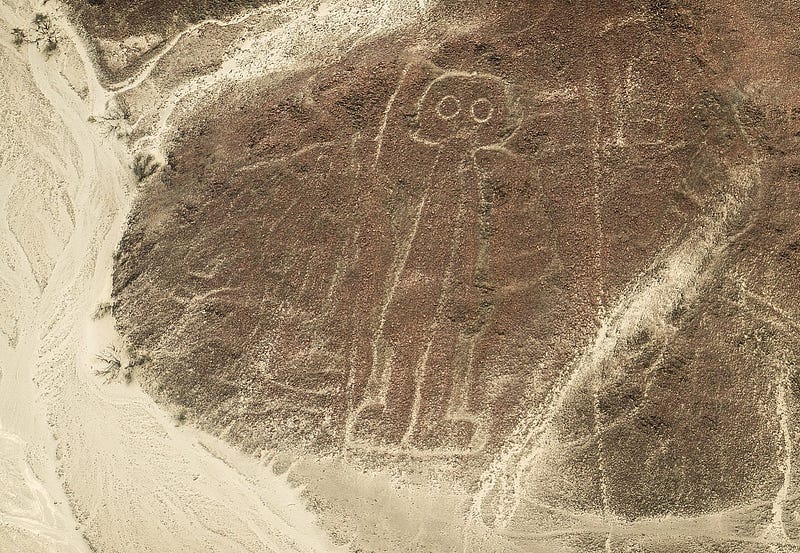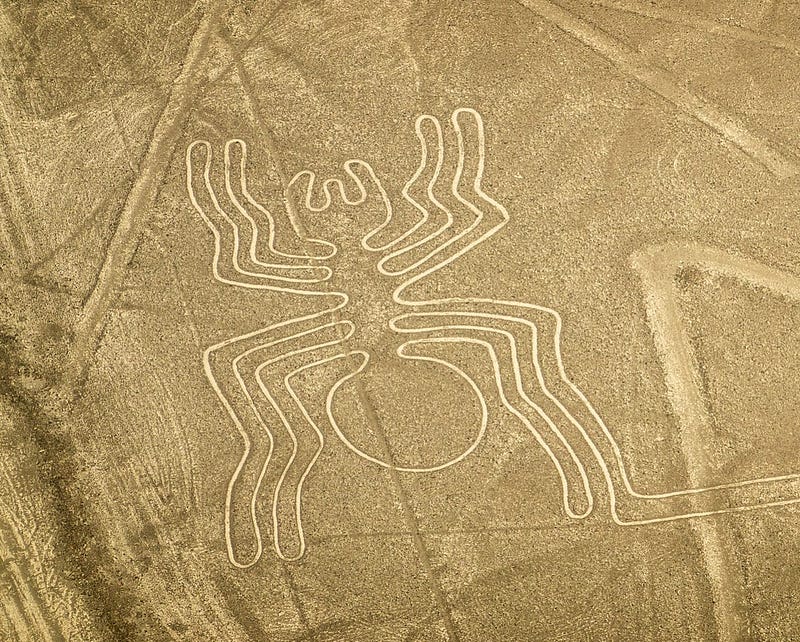Uncovering New Discoveries: 168 Additional Nazca Lines Found
Written on
Chapter 1: The Nazca Lines Unveiled
The Nazca Lines, a fascinating subject in the realm of ancient history, have captivated researchers and enthusiasts alike. Recently, archaeologists have announced the discovery of an additional 168 geoglyphs in Peru, bringing the total known to over a thousand. This remarkable find highlights the enduring intrigue surrounding these ancient artworks and the civilization that created them.

Geoglyphs are ancient designs formed on the earth’s surface, akin to pictographs but crafted from the land itself. These monumental figures can be quite challenging to date, yet they have been discovered across various locations globally, with artifacts dating back thousands of years. Among them, the Nazca Lines stand out as the most renowned and were made by the pre-Hispanic Nazca civilization, known for its advanced culture in ancient Peru. Evidence suggests these remarkable geoglyphs were created between 400 BCE and 650 CE across the dry plains of the Rio Grande de Nazca.

Over the centuries, the Nazca people etched more than a thousand geoglyphs covering an expanse of 75,358.47 hectares (186,214.8 acres). The imagery includes intricate geometric patterns, representations of flora and fauna, and enigmatic human-like figures. These geoglyphs are protected as UNESCO heritage sites, recognized for their unparalleled magnitude, diversity, and historical significance.

Since their discovery by Peruvian archaeologist Toribio Mejia Xesspe in 1926, the Nazca Lines have piqued the interest of experts across various disciplines. Their fame surged in the 1930s with the increase in air travel, allowing more people to view these vast artworks from above. While it is widely believed that the lines can only be appreciated from the air, a 2007 study revealed that all the geoglyphs are visible from the ground as well.
Section 1.1: The Art of Creation
The Nazca Plains provide an ideal setting for crafting geoglyphs due to its arid climate and flat, rocky terrain, which minimizes wind erosion. The surface rocks have developed a dark patina from prolonged sun exposure, contrasting sharply with the lighter soil beneath. The Nazca created these geoglyphs by removing the darker stones to reveal the lighter soil, a method that has allowed many to endure for centuries.
The geoglyphs can be categorized into three main types: linear, geometric, and figurative. The figurative geoglyphs, which depict various tools, plants, animals, and human figures, are further divided into two styles: line-type and relief-type. The line-type geoglyphs are made by the aforementioned removal method, while relief-types involve stacking stones to create their designs.
Subsection 1.1.1: Recent Discoveries
In a significant development, a research team led by Professor Masato Sakai of Yamagata University and Peruvian archaeologist Jorge Olano has discovered 168 new geoglyphs in the Aja region near Nazca, Peru. Their findings, published in The Journal of Archaeological Science in June 2023, stemmed from nearly a decade of exploration, culminating in the identification of these new artworks between June 2019 and February 2020.
Their drone imagery captured over 280 square miles, revealing geoglyphs that depict birds, orca whales, cats, humans, and camelids, dating back to between 100 BC and 300 CE. Notably, while most known Nazca Lines were created using the line-type method, the new discoveries include a majority of relief-type geoglyphs, with only five being classified as line types.
The first video titled "NEW Nazca Lines Hypothesis + 168 New Discoveries | Ancient Architects" discusses the implications of these discoveries and their significance in understanding the Nazca culture.
The second video, "Japanese research team discovers over 160 new Nazca Lines," provides insights into the research methods and findings of the team that made this exciting discovery.
Section 1.2: Future Prospects
Sakai and Olano's findings are momentous, although the number of newly identified geoglyphs is modest compared to the thousands already documented. They are not merely satisfied with cataloging these new discoveries; the researchers are also developing artificial intelligence tools to analyze aerial images and detect geoglyphs like the Nazca Lines. Although AI was not used in this particular study, the images gathered will serve to enhance the system's learning process for future explorations.
In collaboration with local authorities, the researchers are also involved in the conservation of the Nazca Lines by establishing an archaeological park in the Aja region, where many geoglyphs are concentrated. This initiative follows the discovery of 41 geoglyphs in the area in 2014 and 2015, leading to the creation of the park in 2017. Remarkably, 36 of the newly identified geoglyphs are situated within the park's boundaries, bringing the total to 77.
Chapter 2: Reevaluating Perspectives
Conspiracy theories have long suggested that the Nazca people designed these geoglyphs as signals to extraterrestrial beings or as maps for UFOs. This notion stems from the belief that the glyphs are only visible from the sky. However, as the aforementioned study from 2007 indicates, this is a misconception.
Most scientists concur that the geoglyphs were likely created as offerings or messages to their deities, requesting rain and fertility. However, one could entertain the notion that a singular, creative individual might have initiated the first geoglyphs out of sheer boredom, transforming the flat Peruvian landscape into a canvas for artistic expression. This idea opens the door to multiple interpretations of the purpose and meaning behind these ancient creations.
This article was initially featured in the author’s free newsletter, Curious Adventure, and has been edited for publication on Medium with her consent. Thank you for your readership; it is greatly appreciated.